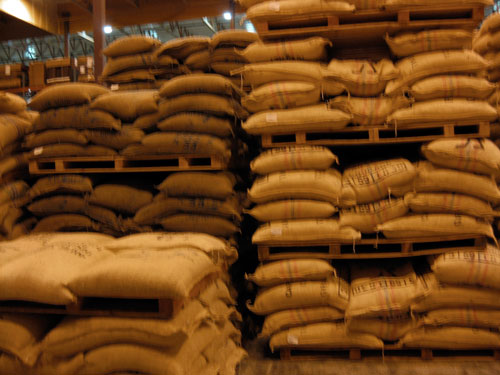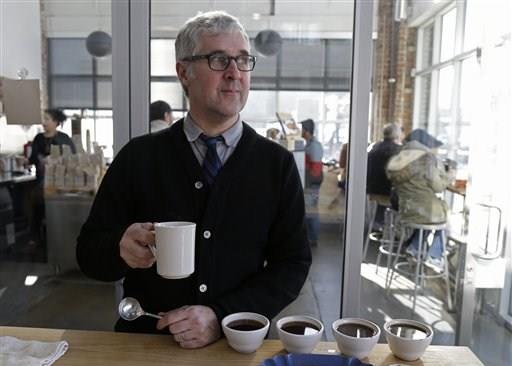The Good.
Boquete is somewhat lucky in that we produce some of the world’s best coffee that is at the top of the pyramid. Otherwise, we would be at the mercy of world markets that are tumbling from an all time high recorded in 2011. See more on “The Expensive” below.
The Bad
Projections by the futures markets indicate that the price of coffee will only rebound in 2015, remaining low until then.
A low growth in demand (no more than 2%) and an increase in production in Brazil (50.8 million kilograms in 2012 to 50 million projected for the 2013 harvest), has led to a fall in price from the $313 earned per quintal in May 2011.
“Since then the trend is downward and will remain so, unless extreme weather conditions affect the production from Brazil and Colombia, stated Raul Amador, VP of Invercasa Puesto de Bolsa and an expert in international markets.
According to Amador, having made “a fundamental and technical analysis of the macroeconomic coffee environment” it can be speculated that “during 2014 and 2015 the price will be maintained between 140 and 160 dollars per quintal.” However, if an escalation of the crisis in Europe and the United States is added to this environment, the tendency would be for the price to drop further. It could break through the bottom floor price of $140 and even fall to to $125 per quintal”, writes Lucydalia Baca Castellón for Laprensa.com.ni
Source: laprensa.com.ni
More Bad – Consequences of Rust in Central America
Another article that I read tells of a coffee blight that is affecting Central America adding to the woes of coffee farmers here.
$300 million will be required for pest control alone, and more than $1 billion to renovate the plantations that have been affected.
The figures which have been gathered unofficially indicated that in excess of 1.7 million quintals of coffee have been destroyed by the fungus known as rust in Honduras, Nicaragua and El Salvador.
The president of the Coffee Exporters Association of Honduras (Adecafeh), Omar Acosta says that the loss in Honduras could reach two million quintals, “The Ihcafé says that no damage has been done, but we do not understand why they are lying. They should have a plan for the country because it is a serious problem, we all know that there is a strong impact from rust and we believe there is a damage of between 25% and 30% of the crop, which amounts to two million quintals. ”
In the case of Guatemala, the losses so far are of about 700 million quintals according to Nils Leporoswki, president of the National Coffee Association (Anacafe) of Guatemala.
“In order to gain support to fight the rust, coffee institutes grouped under the Cooperative Program for the Technological Development and Modernization of Coffee (PROMECAFE) will hold a meeting in San Pedro Sula on 28 February”, noted an article in Canal15.com.ni
Source: canal15.com.ni
The Expensive – A few things to know about that $7 cuppa Joe
Caffeine fans are all atwitter about Geisha beans, a rare and prized high-end coffee made from beans that come from low-producing plants.
Still think a $5 latte at Starbucks is over the top? Hold on, because now there’s an even pricier cuppa Joe to get buzzed about.
These days caffeine fiends are all atwitter about Geisha beans, a high-end coffee so rare and prized it’s being sold for $7 a cup. That’s a lot of dough for a straight up cup of Joe, but worth it say fans of the beans which come from low-producing plants that grow only in certain areas.
“It’s got unique aromatics. It’s just rich with tropical fruits. It’s got tremendous brightness in the cup — sweet and just super interesting stuff,” says Ric Rhinehart, executive director of the Specialty Coffee Association of America, based in Long Beach, Calif. “Coffee people are just in love with it.”
The beans emerged on the market about seven years ago and quickly got the attention of high-end roasters and coffee connoisseurs. Now, the coffee has moved toward the mainstream, being offered at Starbucks and sold by the pound by major companies, including Vermont-based Green Mountain Coffee, which recently introduced its Colombia Geisha Special Reserve coffee as part of its line of rare and premium beans.
Just don’t expect this to become an everyday blend, says Lindsay Bolger, director of coffee for Green Mountain Coffee. “It can’t because it’s limited and obviously we’re not going to be able to carry it year-round,” she says. But when you “really are seeking a very singular, very unique, very rarefied experience with your coffee, this is such a wonderful and convenient way to bring that to coffee lovers.”
Geisha beans originated in the Gesha (no “i”) district of Ethiopia, hence the name. There’s no literal connection to the elegant Japanese hostesses, though Bolger sees a figurative affinity in that the coffee is “very delicate, pure, the flavor expression is refined, graceful, very lovely.”
The plant was taken to Central America at some point and became a sensation during the last decade after a Panamanian farm, Hacienda La Esmeralda, offered the beans at auction. That’s a local coffee plantation here in Boquete. Winner of many International awards for “The Best” and selling wholesale at $170 per pound for a 300 pound lot!!
James Freeman, founder of Blue Bottle Coffee, a small, upscale chain based in the San Francisco Bay Area — it also has outlets in New York City — was among those who were impressed with Geisha coffee when it first emerged. The company now sells tins of beans as well as brewed coffee for around $7 a cup.
“We’re getting a lot of great feedback about how distinctive it is,” Freeman says. “A good Geisha is very much unlike any other coffee that you’ve ever had, so it’s very memorable. It’s not a subtle thing for connoisseurs only.”
Why the high price tag? Not only does the Geisha plant produce relatively few beans, it’s also very sensitive to soils and climate. Plant it in one spot and it’s special, try another and it’s just ordinary coffee, says Bolger. “It requires just the right conditions and it requires very careful handling.”
At Green Mountain, the Columbia Geisha is being sold in 18-count boxes of K-cup packs at $31.99, which works out to about $1.80 per cup. Blue Bottle is selling 150-gram tins at $25, with each tin producing eight to 10 servings.
The quest for superpremium coffees mirrors what’s been going on in other parts of the food world, such as the revival of heirloom tomatoes, says Rhinehart. “We’re always looking for unique flavors or exceptional qualities.”
What Freeman likes about the Geisha trend is that consumers are recognizing the name and getting interested in the concept of searching out different types of beans. “It’s making people pay attention,” he says. “It’s not a 99-cent thing that comes out of a tap.”

